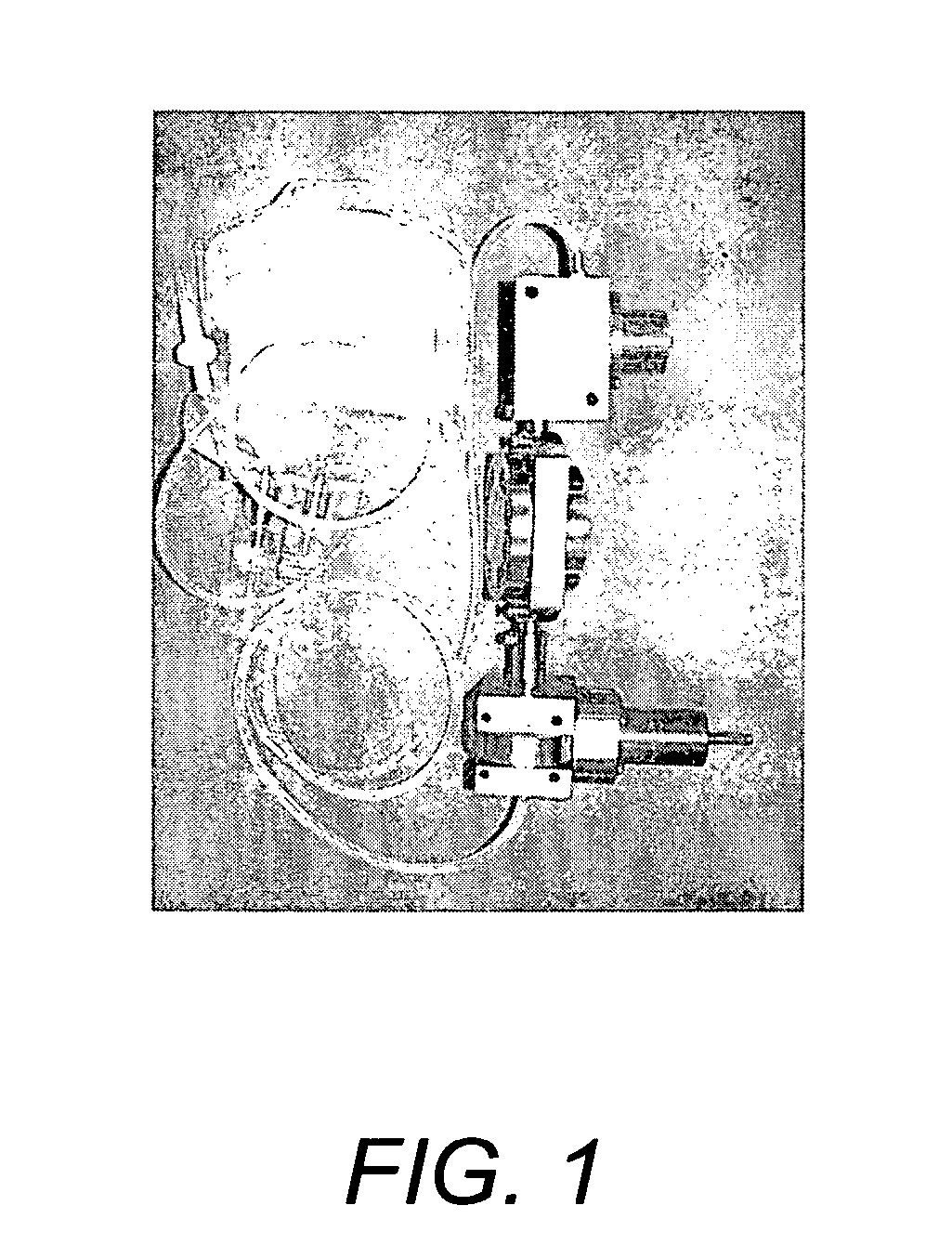Amorphous cell delivery vehicle treated with physical/physicochemical stimuli
a delivery vehicle and amorphous cell technology, applied in the field of functional tissue engineering, can solve the problems of cartilage not being able to regenerate in vivo, physical wear and dislocation of non-living tissues, and the inability to physically regenerate in vivo
- Summary
- Abstract
- Description
- Claims
- Application Information
AI Technical Summary
Benefits of technology
Problems solved by technology
Method used
Image
Examples
example 1
Apparatus for Cultivating Cells or Tissue
[0143] A hydrostatic pressure / perfusion culture system (bioreactor) suitable for use in the in vitro culture methods of the invention is depicted in FIG. 1 and described in U.S. Pat. No. 6,432,713, the entire contents of which are incorporated herein by reference. A schematic drawing depicting the use of a semi-permeable membrane pouch for the culture of cells in a biodegradable amorphous carrier is depicted in FIG. 2. The semi-permeable membrane pouch, containing cells and biodegradable amorphous carrier, is placed within the culture chamber, which is kept horizontal and maintained at 37° C. for a culture period of one to six weeks or more.
example 2
Evaluation of Mass Transfer of Molecular Markers with Biodegradable Polymers in a Semi-Permeable Membrane Pouch After Application of Hydrostatic Pressure In Vitro
[0144] Experiments are performed to evaluate the mass transfer of molecular markers in an amorphous cell carrier through a semi-permeable membrane at static culture conditions as well as at different magnitudes and cycles of fluid pressure. Cartilage ECM has high molecular weight and will stay within the semi-permeable membrane pouch. Degraded cell carrier debris (small molecules) and metabolic waste will be exuded into the medium phase. Under static conditions, nutrients can infiltrate the pouch according to Fick's law. In addition, the bioreactor is used to manipulate mass transfer with defined hydrostatic fluid pressure, medium flow, and controlled oxygen / carbon dioxide concentration. As a model of mass transfer, molecular weight markers are used to evaluate mass transfer under a series of experimental conditions (Table...
example 3
Effects of Hydrostatic Fluid Pressure on Mass Transfer and Degradation of Amorphous Cell Carrier in Semi-Permeable Membrane Pouch
[0146] Biodegradable amorphous polymer (hydrogel or sol / gel reversible polymer) is tested at defined cell culture conditions using a tissue culture system. A semi-permeable membrane pouch is used to hold the cell construct and extracellular matrix products of large molecular weight produced by the chondrocytes. Performance of the pouch is analyzed according to molecular weight cut-off size from 100 to 500 kDa under hydrostatic fluid pressure (HFP) ranging 0 to 5 MPa and 0 to 0.5 Hz. The test carrier is injected into the pouch and evaluated in terms of kinetics of degradation. Fluorescent molecular tracers (e.g., dextran-FITC) ranging from 100 to 500 kDa are used as markers. The fluorescence intensity is measured with a fluorometer using suitably selected wavelengths for fluorescence excitation and detection. From a preliminary study it was observed that d...
PUM
| Property | Measurement | Unit |
|---|---|---|
| molecular weight | aaaaa | aaaaa |
| molecular weight | aaaaa | aaaaa |
| molecular weight | aaaaa | aaaaa |
Abstract
Description
Claims
Application Information
 Login to View More
Login to View More - R&D
- Intellectual Property
- Life Sciences
- Materials
- Tech Scout
- Unparalleled Data Quality
- Higher Quality Content
- 60% Fewer Hallucinations
Browse by: Latest US Patents, China's latest patents, Technical Efficacy Thesaurus, Application Domain, Technology Topic, Popular Technical Reports.
© 2025 PatSnap. All rights reserved.Legal|Privacy policy|Modern Slavery Act Transparency Statement|Sitemap|About US| Contact US: help@patsnap.com



